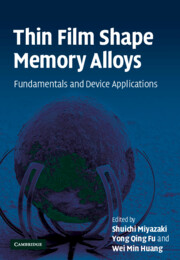Book contents
- Frontmatter
- Contents
- List of contributors
- Preface
- Abstracts of chapters
- 1 Overview of sputter-deposited TiNi based thin films
- 2 Martensitic transformation in TiNi alloys
- 3 Deposition techniques for TiNi thin film
- 4 TiNi multilayer thin films
- 5 Crystallization and microstructural development
- 6 Mechanical properties of TiNi thin films
- 7 Stress and surface morphology evolution
- 8 Ion implantation processing and associated irradiation effects
- 9 Laser post-annealing and theory
- 10 Overview of thin film shape memory alloy applications
- 11 Theory of SMA thin films for microactuators and micropumps
- 12 Binary and ternary alloy film diaphragm microactuators
- 13 TiNi thin film devices
- 14 Shape memory microvalves
- 15 Superelastic thin films and applications for medical devices
- 16 Fabrication and characterization of sputter-deposited TiNi superelastic microtubes
- 17 Thin film shape memory microcage for biological applications
- 18 Shape memory thin film composite microactuators
- 19 TiNi thin film shape memory alloys for optical sensing applications
- Index
9 - Laser post-annealing and theory
Published online by Cambridge University Press: 23 February 2010
- Frontmatter
- Contents
- List of contributors
- Preface
- Abstracts of chapters
- 1 Overview of sputter-deposited TiNi based thin films
- 2 Martensitic transformation in TiNi alloys
- 3 Deposition techniques for TiNi thin film
- 4 TiNi multilayer thin films
- 5 Crystallization and microstructural development
- 6 Mechanical properties of TiNi thin films
- 7 Stress and surface morphology evolution
- 8 Ion implantation processing and associated irradiation effects
- 9 Laser post-annealing and theory
- 10 Overview of thin film shape memory alloy applications
- 11 Theory of SMA thin films for microactuators and micropumps
- 12 Binary and ternary alloy film diaphragm microactuators
- 13 TiNi thin film devices
- 14 Shape memory microvalves
- 15 Superelastic thin films and applications for medical devices
- 16 Fabrication and characterization of sputter-deposited TiNi superelastic microtubes
- 17 Thin film shape memory microcage for biological applications
- 18 Shape memory thin film composite microactuators
- 19 TiNi thin film shape memory alloys for optical sensing applications
- Index
Summary
Abstract
TiNi shape memory thin films have great potential as an effective actuation material for microsized actuators. However, a high temperature (above approximately 723 K) is required in order to obtain crystalline thin films either during deposition (e.g., sputtering) or in post-annealing. Such a high temperature is not fully compatible with the traditional integrated circuit techniques, and thus brings additional constraint to the fabrication process. Laser annealing provides an ideal solution to this problem, as the high temperature zone can be confined well within a desired small area at a micrometer scale. In this chapter, we demonstrate the feasibility of local laser annealing for crystallization in as-deposited amorphous TiNi thin films and present a systematic study of the theories behind this technique.
Introduction
TiNi shape memory thin films have great potential as an effective actuation material for microsized actuators [1]. As compared with other materials, such as electrostatic, electromagnetic and piezoelectric thin films, the work output per unit volume of TiNi shape memory thin films is significantly higher, because they are able to provide not only a larger force but also over a longer displacement [2]. In addition, the disadvantage of slow response speed in bulk shape memory alloys (SMAs) can be dramatically improved due to a larger surface-area-to-volume ratio in thin films. 20 Hz frequency has been achieved in a TiNi thin film based microvalve [3]. Furthermore, TiNi shape memory thin films can be fabricated by techniques which are compatible with the well-established batch-processing technology of Si micromachining [1, 4]. A number of microdevices have been realized using TiNi shape memory thin films, as presented in Chapters 10 to 19.
- Type
- Chapter
- Information
- Thin Film Shape Memory AlloysFundamentals and Device Applications, pp. 226 - 260Publisher: Cambridge University PressPrint publication year: 2009



